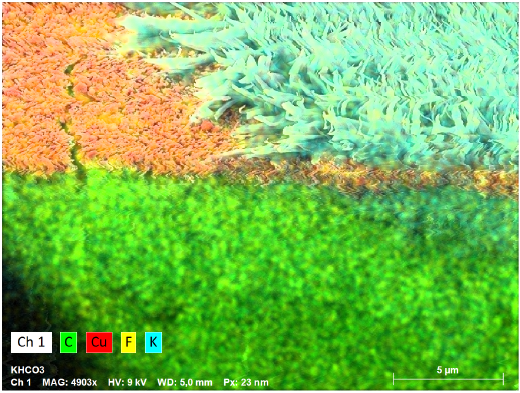Carbon dioxide - a greenhouse gas - can be converted into valuable hydrocarbons via the process of electrolysis. In this procedure, the design of the electrolysis cell is essential. The so-called zero-gap cell is especially suitable for industrial processes. However, there are still some limitations: The cathodes can clog up rather quickly.

The EDX measurement shows that at higher concentrations of dissolved potassium compounds in the electrolyte, potassium crystals are deposited on the cathode (right upper corner). Image Credit: © HZB
Dr. Matthew Mayer and his team at the HZB have now explored what causes this and how this unwanted process can be prevented.
Carbon dioxide, or CO2, is produced when oil, coal, or natural gas are burned. This well-known greenhouse gas is a significant contributor to global warming, but it is also a raw material. Technically, it is feasible to transform CO2 into usable carbon compounds. However, this process requires energy, water, appropriate electrodes, and special catalysts.
CO2 can be transformed electrochemically into carbon monoxide, formate, or methane, as well as ethylene, propanol, acetate, and ethanol. However, industrial processes must be designed to be highly selective and extremely efficient to produce only the desired products and not a mixture of products.
Converting CO2 Back into Fuel
By electrolytically reducing CO2 to useful hydrocarbons, we can produce new fuels without using fossil resources. We thus are putting the CO2 back into the cycle, just like recycling.
Dr. Matthew Mayer, Leader, Helmholtz Young Investigator Group “Electrochemical Conversion”
The electrolysis process can be made more sustainable using renewable energy sources such as wind or solar.
The Zero-Gap Cell: A Sandwich of Many Layers
Students often learn in school that electrolysis can be performed in a basic beaker of water; further development of this is the H-cell, which is shaped like the letter H.
However, such cells are not designed for industrial use. Instead, industrial electrolyzers are fabricated with a sandwich architecture consisting of several layers: On the left and right are the electrodes that conduct the current and are coated with catalysts, a copper-based gas diffusion layer that lets in the CO2 gas, and a separation membrane.
The electrolyte (called anolyte when provided at the anode) is made up of dissolved potassium compounds and permits ions to travel between the electrodes. The membrane allows positively charged ions through while blocking negatively charged potassium ions.
The Problem: Potassium Crystals
Nevertheless, potassium ions from the electrolyte pass through the membrane and form tiny crystals at the cathode clogging the pores.
The researchers were able to analyze the process of crystal formation at the cathode in depth using scanning electron microscopy and other imaging techniques.
“This shouldn't happen. With energy-dispersive X-Ray analysis, we were able to locate the individual elements and show exactly where potassium crystals were forming,” states Flora Haun, a Ph.D. Student in Matthew Mayer’s team.
According to the findings, the more potassium in the electrolyte, the more the cathode clogs. There is no simple solution to this: lowering the potassium concentration is excellent on the one hand but harmful on the other because the reaction equilibrium shifts, producing carbon monoxide instead of the desired ethylene.
The Electrolyte is the Key
The most important observation is that cations can still penetrate the anion exchange membrane, but to an extent that depends on the concentration of the electrolyte. And that with the concentration of the electrolyte we simultaneously regulate which products are formed from the CO2.
Dr. Gumaa El Nagar, Postdoctoral Researcher, Helmholtz-Zentrum Berlin für Materialien und Energie GmbH
Dr. Gumaa El Nagar concludes, “In the next step, we want to use operando and in situ measurements using X-Rays to find out in detail how ion migration in the cell affects the chemical reaction processes.”
Journal Reference:
El-Nagar, G. A., et al. (2023). Unintended cation crossover influences CO2 reduction selectivity in Cu-based zero-gap electrolysers. Nature Communications. doi.org/10.1038/s41467-023-37520-x.